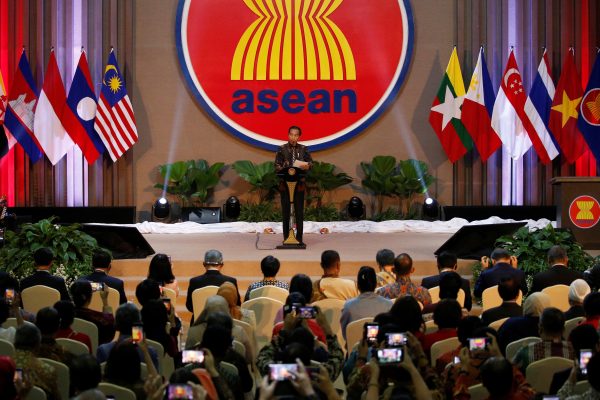Fifty years later, Indonesia was a significant promoter of the ASEAN Charter which gave the association a legal foundation. Yet it is unclear why Indonesia has not sought to build an institutional framework around the latest regional construct, the Indo-Pacific.
Since ASEAN’s founding, Indonesia has sought an institutional response when challenged by other regional constructions that threaten ASEAN’s pre-eminence. In the late 1990s, former Malaysian prime minister Mahathir Mohamad sought to promote his idea of an ethnically Asian, East Asian grouping — one which had the potential to diminish ASEAN’s importance.
Indonesia’s Ministry of Foreign Affairs mobilised to have Mahathir’s project both co-opted and formalised into the annual East Asia Summit (EAS). Participation was widened beyond East Asia to include Australia, India, New Zealand, Russia and the United States. The EAS has since been a major way for ASEAN to exert influence as the heart of a new regional construct. After the first EAS the term ‘ASEAN centrality’ entered the association’s lexicon.
Since 2013, the Indo-Pacific idea has challenged the place of ASEAN in the regional architecture. As a response, Indonesia drafted the ASEAN Outlook on the Indo-Pacific (AOIP) and had it approved at the June 2019 ASEAN Summit. The AOIP proposes no particular strategy on the Indo-Pacific and avoids the ASEAN jargon of ‘vision’ that is reserved for aspirational goals. It simply suggests a shared view or lens on the status quo. Indonesia did not seek, as it did for the EAS, to formalise an ASEAN-centric institutional framework around the Indo-Pacific.
Four factors explain Indonesia’s unwillingness or inability to formalise an ASEAN-centric institutional framework around the Indo-Pacific idea. First, the concept has largely been promoted by non-East Asian powers, including the four members of the Quad: Australia, India, Japan and the United States. This poses a challenge for ASEAN-centric institutionalisation. Vietnam, for example, is already considered to be an adjunct Quad member by some. Despite Philippine President Rodrigo Duterte’s anti-American and pro-Chinese rhetoric, China’s assertiveness in the South China Sea is pushing the Philippines to follow suit.
Second, the creation of another regional institution may appear redundant at this juncture in international politics. Seen from Jakarta, the ASEAN Regional Forum (ARF) — with its ASEAN-centric basis and de facto Indo-Pacific membership — is adequate to manage shifting conceptions of the region. Indonesia’s Bali Democracy Forum also involves many of the same countries. Only Malaysia shares some marginal interest in an Indo-Pacific reality within ASEAN. Yet it has not expressed any desire to formalise its existence.
The third factor is related to ASEAN practice. To symbolically acknowledge the existence of an Indo-Pacific as beneficial can be likened to ASEAN’s token acknowledgement of the importance of human rights and democracy. No further steps were required after Indonesia approved the Indo-Pacific idea with ASEAN deemed to be at its centre. At the same level of symbolism, prompted by the new Biden administration, on 18 February a rebolstered Quad alluded to ASEAN’s centrality.
A final factor is Indonesia’s ‘introverted regionalism’. From the first use of the term by Indonesia’s former foreign minister Marty Natelegawa in 2013, the Indo-Pacific epithet is about describing Indonesia itself. Its roots lie in the concept of Wawasan Nusantara (Indonesian Archipelagic Vision) first mooted in 1957. In the lead up to the 2014 Indonesian presidential election, Indonesian President Joko ‘Jokowi’ Widodo promoted Indonesia as a Poros Maritim Dunia — translated as a Global Maritime Fulcrum (GMF).
The concept was initially announced to a domestic audience as part of Jokowi’s victory speech. He promised that Indonesians would see their maritime homeland entering into a new golden age, evoking memories of the historic maritime Majapahit and Srivijaya empires. Following Jokowi’s presidential inauguration, the GMF morphed into a foreign policy approach. It was dubbed the Jokowi doctrine and based on the five pillars of Pancasila (the official Indonesian state philosophy). Yet it took until January 2021 for an Omnibus Bill on Maritime Security to give the GMF concrete expression in legal terms.
The AOIP discourse today is akin to the GMF rhetoric during Jokowi’s first term in office. The AOIP provides a projection of Indonesia as quintessentially part of the Indo-Pacific. This state of being requires no new institutional form.
David Camroux is an Honorary Senior Research Fellow at the Center for International Studies (CERI), Sciences Po, Paris, and a Professorial Fellow at the University of Social Sciences and Humanities, Vietnam National University, Hanoi. He is a former Dissemination Coordinator for the CRISEA project on Southeast Asian regional integration financed within the European Union’s Horizon 2020 Framework Programme.

